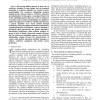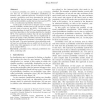1074 search results - page 30 / 215 » Rule sets based bilevel decision model |
DMIN
2006
15 years 1 months ago
2006
Discovering hidden patterns in large sets of workforce schedules to gain insight into the potential knowledge in workforce schedules are crucial to better understanding the workfor...
ICML
1990
IEEE
15 years 3 months ago
1990
IEEE
Given an adequate simulation model of the task environment and payoff function that measures the quality of partially successful plans, competition-based heuristics such as geneti...
125
click to vote
KESAMSTA
2007
Springer
15 years 6 months ago
2007
Springer
This work proposes a framework for the design and development of Ontology Agents oriented to manage Rule Base Fuzzy Cognitive Maps (RBFCM). The approach takes into account the foun...
LPNMR
1999
Springer
15 years 4 months ago
1999
Springer
We introduce choice logic programs as negation-free datalog programs that allow rules to have exclusive-only (possibly empty) disjunctions in the head. Such programs naturally mod...
SDM
2010
SIAM
15 years 1 months ago
2010
SIAM
A relational probability tree (RPT) is a type of decision tree that can be used for probabilistic classification of instances with a relational structure. Each leaf of an RPT cont...


